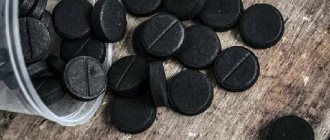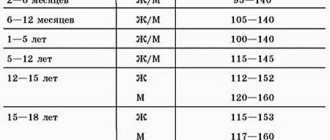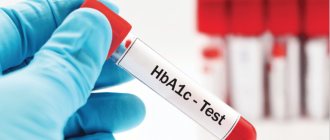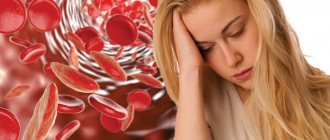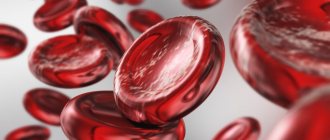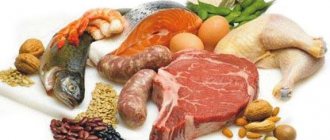Increased hemoglobin is a fairly common phenomenon in men of different ages.
A more common and well-known problem is low hemoglobin, which leads to anemia; increased hemoglobin is no less dangerous; it is probably to some extent more dangerous than low hemoglobin, in that the phenomenon can lead to the development of myocardial infarction and stroke in humans.
Not everyone knows about the consequences of the process of hemoglobin disturbance in the body; such a condition can signal the occurrence of pathological processes in the body.
Often a man does not know about these processes until he takes a blood test.
Hemoglobin should not be allowed to exceed 180 g/l ; if this happens, the reason that caused such a rise must be immediately found out and treated.
Subsequently, an increased level of hemoglobin in the blood may be a reason to contact a specialist due to irreversible processes in the body.
Reasons for increased hemoglobin in men
Functional and pathological factors can influence hemoglobin levels. Normal physiological, adaptive and compensatory mechanisms operate under certain conditions of climate, altitude, latitude, etc.
These include:
Long-term presence and residence of a person in high mountain areas. Low atmospheric pressure causes a response from the body, which consists of deepening and increasing breathing in order to compensate for the lack of oxygen supply from the rarefied air. This is a short term reaction. Then a longer adaptive mechanism develops, which increases the number of red blood cells in the blood and, accordingly, hemoglobin. The duration of its formation is from a week to 2 months. After a transition period, breathing evens out and slows down again. The process plays a role in the development of mountain sickness in climbers. This unpleasant pathology develops in the case of a sharp rise to a high altitude without adaptation;
excessive physical stress. From a one-time load, the adaptive mechanisms of increased gas exchange will not have time to work, but if the overload lasts a long time, then the blood will react by increasing the number of red blood cells and the hemoglobin content. This reaction of the body aims to relieve the respiratory system and cardiovascular system. Therefore, often in men associated with constant heavy physical labor, hemoglobin numbers are higher than normal. A similar phenomenon occurs in athletes experiencing monotonous daily overload. For example, long-distance runners, cyclists, skiers, etc.
functional types of dehydration are intermediate between physiological and pathological causes of increased hemoglobin;- living in conditions with insufficient water. For example, working in a hot climate and without proper drinking conditions. In this case, an irreplaceable loss of fluid occurs, leading to “thickening” of the blood. These types of work are more typical for men, so functional dehydration is more common among them.
Please note: the longer a person works and lives in such conditions, the more hyperhemoglobinemia develops and the risk of complications increases.
An increase in hemoglobin in men can develop as a result of diseases:
- occurring with debilitating and prolonged diarrhea, especially accompanied by concomitant vomiting (infectious diseases);
- with excessive urination due to diabetes, chronic stress, kidney disease;
- chronic heart failure, causing swelling of the body and a compensatory increase in fluid secretion by the kidneys;
- malignant polycythemia vera (Vaquez disease).
Long-term use of diuretics and a number of other drugs, and deficiency of cyanocobalamin (vitamin B12) can lead to dehydration and thickening of the blood.
Frequently asked questions and doctor's answer
General practitioner Victoria Druzhikina answered questions
1. What is Hemoglobin indicated in a blood test?
- “In a general blood test, hemoglobin is abbreviated as Hb, measured in grams per liter.” 2. Why is low Hemoglobin dangerous?
– “Low hemoglobin levels are dangerous due to anemia and its consequences:
- oxygen starvation of organs and tissues, primarily nervous;
- muscle weakness;
- fainting due to decreased blood pressure;
- decreased immunity;
- wear and tear of the heart muscle due to the development of compensatory tachycardia in conditions of lack of oxygen;
- heart attacks;
- retardation in mental and physical development.
In severe cases, untreated anemia can lead to hypoxic coma and death due to brain or heart failure.”
3. Blood transfusion for low hemoglobin
– “To treat severe forms of anemia, blood or red blood cell transfusions are used. The procedure is indicated in 2 cases:
1. With a hemoglobin level of 70 g/l and below.
2. In case of poor tolerance to anemia and the threat of hypoxic coma at any level of hemoglobin. This can occur in people whose lives involve high oxygen consumption - pregnant women, athletes, scuba divers playing wind instruments.
The standard regimen is 2 doses (1 dose – 200 ml) twice a week. Before and after the procedure, general urine and blood tests and temperature must be monitored.
Before the manipulation, the patient’s blood type and Rh factor are determined, and donor blood is selected based on these indicators. Next, the compatibility of the blood samples is checked. If the reaction proceeds normally, a transfusion is performed. If flakes or clots form, this blood is not transfused, but other samples are tested for compatibility.” 4. Hemoglobin norm in children under one year old
– “The hemoglobin norm in children under one year of age is determined by physiological factors. By the end of the 1st month, the numbers are higher than in adults and amount to 160–200 g/l.”
5. How to increase Hemoglobin in a child?
“If anemia is detected, it is important to increase hemoglobin levels as soon as possible, especially in children. The main role in this belongs to drugs. Unfortunately, nutrition will not significantly increase the numbers. With the help of food, you can only slightly improve your performance and maintain it at this level.
Foods to increase hemoglobin in children:
- beef;
- buckwheat;
- cocoa;
- liver;
- apples;
- pomegranate;
- walnuts.
Drugs for the treatment of anemia in children:
- Maltofer;
- Ferrum Lek;
- Totema;
- Ferlatum and others"
6. How to increase hemoglobin during pregnancy?
“During pregnancy, it can be difficult for a woman to follow a diet with foods rich in iron. However, their list is quite wide, you can choose what you like:
- beef;
- wheat bran;
- hazelnuts;
- cabbage, including broccoli;
- chocolate;
- rabbit;
- liver;
- cocoa;
- apples;
- pears;
- parmesan, etc.
How to increase hemoglobin during pregnancy - the most used drugs:
- Maltofer;
- Sorbifer Durules;
- Ferrum Lek;
- Gyno-tardiferon;
- Totema;
- Ferlatum and others."
7. Iron supplements to increase hemoglobin in adults
– “To treat anemia in adults, the same drugs are used as for pregnant women. Can also be used:
- Venofer;
- Ferlatum protein;
- Cosmopher;
- vitamin complexes with iron (Ferro-Folgamma, Fenyuls, etc.).”
8. Normal Hemoglobin in Newborns? – “The hemoglobin norm varies slightly from month to month, the generally accepted average values are 120–160 g/l.
Immediately after birth, the mother’s blood circulates in the baby, so values from 180 to 240 g/l are considered normal for the 1st week of life.”
For information on hemoglobin levels, see also the video:
This article has been verified by a current qualified physician, Victoria Druzhikina, and can be considered a reliable source of information for site users.
Bibliography
1. The norms of indicators are indicated in Appendix No. 3 of Order of the Ministry of Health of the Russian Federation dated 09/14/2001 364 (as amended on 06/06/2008)
Rate how useful article
4.7 was. 29 people voted, average rating 4.7
Did you like the article? Save it to your wall so you don’t lose it!
How does increased hemoglobin manifest in men?
High hemoglobin can cause a number of nonspecific symptoms (also found in other diseases).
They appear:
- the appearance of reddened areas of the skin, alternating with pale areas, peeling;
- severe weakness and fatigue, decreased appetite;
- decreased hearing and vision;
- alternating constipation and diarrhea;
- superficial sleep, insomnia;
- pain in joints, muscles, bones;
- dizziness, diffuse headache;
- tendency to form blood clots;
- painful sensations in the abdomen and a feeling of fullness.
Anemia... Is it always due to gastritis and lack of iron?
Anemia is not an independent pathology; it is a symptom that accompanies a number of diseases that are not always associated with the hematopoietic system. Thus, anemia often occurs with gastrointestinal diseases, metabolic diseases, when the absorption of iron or vitamin B12 is impaired. Anemia is diagnosed when the concentration of hemoglobin in the blood decreases, the number of red blood cells decreases, or their qualitative composition changes.
Symptoms and dangers of anemia
Examination of a child with frequent colds
If a child has frequent, severe colds and acute respiratory viral infections, our center will find out the cause of this condition
The main task of red blood cells is to transport oxygen to tissues. If red blood cells or hemoglobin are defective or their concentration is insufficient, the body suffers from oxygen starvation. Because only in the presence of oxygen does energy production become possible. In other words, the body simply does not have enough strength to live and function normally. Hence the manifestations of the disease; an experienced doctor will suspect anemia based on an examination by a doctor:
- cyanosis of the skin and mucous membranes;
- shortness of breath with minor exertion (the body compensates for the lack of oxygen by trying to inhale more air);
- hair loss and thinning;
- poor condition of nails (brittleness, thinness, lamination);
- tachycardia and palpitations even with minor exertion;
- memory impairment, decreased performance, sleep disturbances and other neurological symptoms such as lethargy, apathy, nervousness;
- “flies” before the eyes;
- dizziness when suddenly changing position
With serious anemia, pain in the heart, swelling of the limbs, pain in the limbs, even cramps and intermittent claudication occur. There may be food perversions - desire for bitter things, eating ice, sand, earth.
Children with anemia are stunted in growth and development, women experience menstrual irregularities, and have problems conceiving (including miscarriages).
Acute anemia is easily treated; often only nutritional correction is sufficient. They occur after blood loss (trauma, surgery). Acute anemia can also be called anemia in pregnant women (if the woman never had anemia before pregnancy). WHO allows a natural decrease in hemoglobin in the third trimester to 105 g/l, and in the first two to 110 g/l. If the fetus’s nutrition is not impaired, the woman does not complain, her diet is complete, often the doctor does not prescribe treatment, monitoring only the hemoglobin level. Nowadays, various diets have become fashionable, including those with the complete exclusion of animal foods, this contributes to the growth of iron deficiency anemia among healthy people.
B12 deficiency anemia
It is considered a relatively simple form, red blood cells and hemoglobin molecules are not changed, hematopoiesis is normal, but anemia occurs due to a lack of vitamin B12. In this case, the deficiency should be chronic; only 5-6 years after the cessation or decrease in the supply of vitamin B 12 does anemia occur. If such anemia is not detected in a timely manner and the lack of vitamin B12 is not compensated for, the type of hematopoiesis changes, which can lead to serious problems. Most often, B12 deficiency anemia occurs due to gastrointestinal diseases:
- inflammatory and atrophic diseases of the intestines and stomach;
- operations on the gastrointestinal tract with partial or complete resection of one of the areas;
- parasites (tapeworms, etc.);
- liver diseases;
- constant use of certain medications (for example, anticonvulsants).
In addition, such anemia accompanies other blood diseases - leukemia, erythromyelosis.
What to do: first of all, take a detailed blood test, the hematologist will see the changes, collect anamnesis and, if necessary, involve other specialists - most often a gastroenterologist and an infectious disease parasitologist. This type of anemia responds well to treatment or compensation, with the exception of blood cancer.
Previously, B12 deficiency anemia was observed in children who were fed goat milk or powdered milk. Today, even formula-fed children who receive formula are protected from anemia.
The main danger: a long asymptomatic period. If you have gastrointestinal diseases, you often eat fish or medium-cooked meat, or have “problems” with your liver, take a detailed blood test regularly.
Iron-deficiency anemia
The main reason is loss of iron with hidden bleeding or lack of it in food. Congenital iron deficiency and iron transport disorders are rare. Long, heavy menstruation in women depletes the body, they are not the norm, and the iron supply does not have time to be replenished. The second reason is chronic minor bleeding of the gastrointestinal tract - they are detected by tests for occult blood in the stool. Infectious diseases and serious burns can contribute to the development of iron deficiency anemia. Another reason is malnutrition, this is especially dangerous in childhood during the period of active growth - from birth to 2-3 years, when the body actively accumulates, but also consumes iron no less actively. The second stage is puberty - girls begin menstruation.
Previously, it was believed that gastritis was one of the causes of iron deficiency anemia, but no, atrophic gastritis occurs in response to a lack of iron.
For diagnosis, it is not enough to take a blood test; you need to find out at what stage the anemia is. Since the body initially uses tissue iron, the tests in this case will be normal. You also need to get tested for serum iron, ferritin and transferrin.
If detected in a timely manner, the prognosis is usually favorable, the patient is either cured completely or takes iron supplements according to the prescribed regimen. Of course, it is recommended to change your diet, choosing a balanced diet rich in microelements, vitamins and not giving up protein foods.
Anemia associated with disturbances in red blood cells and hemoglobin
It is these anemias that are chronic pathologies, the most severe of which are associated with the inability of the bone marrow to regenerate:
aplastic anemia (bone marrow does not produce enough blood cells). In severe cases, a bone marrow transplant is required. Bone marrow suppression can be congenital or acquired. Main reasons:
- poisoning by chemicals (in particular heavy metals);
- ionizing radiation (radiation);
- taking medications (in some cases, aplastic anemia is observed only while taking medications, in others it can be persistent)
- infectious diseases (severe infections in risk groups)
- autoimmune diseases.
hemolytic anemias are associated with increased destruction of red blood cells. Usually the structure of the erythrocyte is disturbed, there is a deficiency of enzymes, there are disturbances in the hemoglobin molecule - these anemias are congenital and are often hereditary. Acquired hemolytic anemia most often occurs due to the toxic effects of hemolytic poisons, immune diseases, and often hemolytic anemia complicates operations for prosthetic heart valves. A striking example of hemolytic anemia is jaundice in newborns - maternal antibodies destroy the red blood cells of the fetus, as a rule, the prognosis is favorable, but some children require a blood transfusion - as soon as the antibodies leave the body, hematopoietic functions are completely restored. Sometimes hemolytic anemia may be the only manifestation of lymphoma.
This is a brief excursion into anemia; in fact, their classification is quite complex, but the first two pose a real threat to a group of healthy people, as they are diagnosed too late. The therapist will not always offer to take extensive tests or conduct biochemical studies.
What to do? Regular monitoring of blood tests and scheduled visits to the doctor are enough for people who are considered healthy. If you are at risk, the doctor will determine treatment tactics, taking into account diagnostic data.
What tests are taken if anemia is suspected (minimum list)
- Prelatent iron deficiency:
- Ferritin is either reduced or has a tendency to decrease
- Transferrin and percentage of transferrin saturation are within normal limits
- Iron is within normal limits
- Complete blood count and hemoglobin content in red blood cells are within normal limits
Latent iron deficiency
- Ferritin is reduced in women <10 µg/l, in men <20 µg/l
- Transferrin > 4g/l;
- Transferrin saturation in women <15%, in men <20%
- Iron in women <8 µmol/l in men <11 µmol/l
- Complete blood count and hemoglobin content in red blood cells are within normal limits
Iron deficiency
- Ferritin is reduced in women <10 µg/l, in men <20 µg/l
- Transferrin > 4g/l;
- Transferrin saturation in women <15%, in men <20%
- Iron in women <8 µmol/l in men < 11 µmol/l
- hemoglobin content in red blood cells <80fl
- hemoglobin 100-120 g/l
You can take a blood test with us without having to visit a doctor, but you can make an appointment with a therapist or hematologist for an extended consultation if there are abnormalities in the analysis. At the same time, the danger of self-diagnosis is that one basic analysis may not be enough, you remember that some anemias begin to appear only after 5-7 years
Diagnosis of elevated hemoglobin
Detection of an increased number of red blood cells and hemoglobin is determined during a routine clinical blood test. If the doctor suspects the cause of this process, he may order additional tests. After establishing a diagnosis or functional state, a plan of treatment measures, drug therapy is drawn up, and a diet is prescribed.
Please note: before you start sounding the alarm, compare the test results with the reference values - they are different for men and women!
| Age | Men (g/l) | Women (g/l) |
| Hemoglobin norms in adults | ||
| Over 65 years old | 126 – 174 | 117 – 161 |
| Over 45 years old | 131 – 172 | 117 – 160 |
| Over 18 years old | 132 – 173 | 117 – 155 |
| Hemoglobin norms in adolescents | ||
| 15 – 18 years old | 115 – 165 | 115 – 155 |
| 12 – 14 years old | 120 – 160 | 115 – 150 |
Table of hemoglobin norms in children by age
In newborns, the density of hemoglobin in the blood has maximum values. Then its content gradually decreases, a certain stability of indicators appears only at 6 months. This condition persists until the child reaches 5 years of age, after which the concentration of the enzyme begins to increase again.
It is also worth considering that when a child reaches the age of 12 years, it is necessary to analyze protein indicators based on his gender. They will be different for boys and girls.
The norm of hemoglobin in the blood of children by age is shown in the table:
| Age | Boys | Girls |
| from 0 to 15 days. | 160 — 200 | 160 — 200 |
| 1 - 3 months | 120 — 160 | 120 — 160 |
| 4 - 6 months | 95 — 140 | 95 — 140 |
| 6 – 12 months | 110 — 145 | 114 — 150 |
| 1 - 2 g. | 110 — 130 | 110 — 130 |
| 2 - 5 l. | 105 — 150 | 105 — 145 |
| 5 - 11 l. | 110 — 140 | 110 — 140 |
| 12 - 14 l. | 120 — 140 | 120 — 140 |
| 15 - 17 l. | 120 — 155 | 120 — 150 |
Treatment methods aimed at reducing hemoglobin in men
If the load is excessive, it is recommended to reduce its intensity. This should be done if the patient has the complaints outlined above.
For diseases of the cardiovascular system, it is necessary to identify the pathology and carry out treatment, which will lead to the normalization of hemoglobin analysis data.
If hemoglobin increases due to diabetes mellitus, it is necessary to reconsider the nutrition plan and introduce correction of insulin doses.
If the treatment does not reduce the level of hemoglobin in the blood, then you should consider prophylactic administration of anticoagulants and antiplatelet medications. These include acetylsalicylic acid, the dose of which must be selected by the doctor.
Insufficient absorption of vitamin B12 should be compensated by prescribing the medication in injection form.
Please note: if the main cause of increased hemoglobin in men is caused by an existing disease, then its treatment, if the tactics are chosen correctly, will itself normalize the deviation of indicators from normal numbers.
How to quickly reduce hemoglobin in the blood at home?
Minor fluctuations in Hb levels caused by sports training or stress do not require the use of special correction methods.
The first thing you have to do to lower hemoglobin is to adjust your daily menu and diet. It has been noted that a diet with increased hemoglobin in men can achieve noticeable results in improving health.
And if the condition is not accompanied by concomitant diseases, it will allow the patient to avoid the need for drug treatment. Therefore, you should pay special attention to this issue and strictly follow nutritional recommendations.
The patient’s attending physician is responsible for preparing the diet, since many factors must be taken into account: the presence of pathologies, intolerance to certain foods and the reason that caused the Hb deviation from the norm. Let's look at the basic principles and recommendations for nutrition.
Read further: All about the norm of hemoglobin in the blood of men by age
Diet therapy
A diet to reduce hemoglobin in the blood does not involve reducing the consumption of iron-containing foods.
It is necessary to sharply reduce the consumption of iron-containing products in case of hemochromatosis - this is a congenital pathology that is accompanied by abnormal deposition of iron in excess quantities.
You should consume soups at least once a day every day. Even in the summer, when it is too hot, it is possible to diversify your diet with cold soups - okroshka, gazpacho or botvinya.
The consumption of red fish and meat, especially fatty varieties, should be limited.
Preference should be given to vegetable and fermented milk dishes. It is worth noting 2 advantages of vegetables: a large amount of liquid in their composition and a low content of iron ions. Dairy products compete with iron ions for absorption, so increasing their share in the diet will significantly slow down the flow of iron into the body.
It is useful to include grapes, tofu cheese, rice, and bread in the menu.
About the importance of water
Some men deliberately limit their fluid intake in the summer in order to sweat less. However, this is an erroneous tactic of behavior that leads to dehydration and a decrease in oxygen in the tissues. The consequence is the manifestation of unwanted symptoms:
- increased craving for sleep;
- frequent headaches;
- state of lethargy;
- general weakness;
- worsening mood.
In parallel with this, blood thickening occurs, the danger of which was discussed above. In order to avoid this condition, it is necessary to consume a minimum amount of fluid, which is calculated taking into account the weight and physical activity of each person.
You should choose green tea, compotes and fruit drinks. It is better to avoid coffee, carbonated drinks and juices. Because they do not quench thirst and increase sweating.
It is optimal if a man drinks 100 ml of unsweetened water at room temperature every hour.
Forbidden foods
Taking any vitamins and nutritional supplements should be discussed with your doctor in advance. Since an excess of certain groups of vitamins can increase the absorption of iron and the production of blood cells. Particular attention should be paid to vitamin C, a sufficient daily amount of which a man receives with food if the menu is properly composed.
A large number of iron ions are typical for seafood, especially sea fish. During treatment, it is advisable to completely exclude them from the diet or minimize them.
You will also have to reduce the amount of sugar consumed, and, accordingly, all sweet baked goods, chocolate and candies. Despite the low iron content in their composition, they create a favorable environment in the gastrointestinal tract (GIT) for enhanced absorption.
It is also necessary to limit the consumption of alcoholic beverages.
Folk remedies
The use of alternative medicine methods cannot act as a full-fledged alternative to traditional methods. Folk remedies are an addition to the prescribed treatment. However, their use must be previously agreed upon with the attending physician. This is necessary to eliminate the risk of reducing the therapeutic effectiveness of drugs by various substances from traditional medicine.
One of the recommended traditional medicines is mumiyo. Available in the form of powder, tablets or capsules. It should be emphasized that during its use it is strictly forbidden to drink alcohol and smoke.
Bloodletting using medicinal leeches was also used to lower Hb levels. However, there is currently no reliable confirmation of the effectiveness of this method.
Preventive measures to prevent increased hemoglobin in men
Regular clinical blood tests will help to recognize hyperhemoglobinemia in time and make the right decision to prevent its development.
Examinations by a doctor will allow you to suspect a possible disease leading to an increase in the number of red blood cells and hemoglobin and begin its treatment.
A proper lifestyle and diet will help prevent the development of dangerous blood thickening processes.
Stepanenko Vladimir, surgeon
111,470 total views, 7 views today
( 53 votes, average: 4.62 out of 5)
Lymphoblastic leukemia: symptoms and treatment
Lemierre's syndrome: causes, symptoms, treatment tactics
Related Posts
How to increase low hemoglobin
Even a slight decrease in hemoglobin levels requires treatment. Otherwise, the man’s well-being will progressively deteriorate. Therefore, from the moment a general blood test is performed and low hemoglobin levels are established, it is necessary to make adjustments to the daily diet and start taking iron-containing medications. It is impossible to cope with the problem only by changing the diet and increasing the amount of iron sources in the body, since at best, as much of this trace element is absorbed from food per day as is consumed. This will not allow the formation of the necessary depots and eliminate the risk of re-development of anemia in the near future.
It is imperative that in combination with the treatment of anemia, therapy for the disease that provoked its development is prescribed. Accordingly, it will be strictly specific in each individual case.
Nutrition correction
With low hemoglobin, men are advised to increase the amount of iron-rich foods in the daily menu, as well as those containing folic acid, vitamin B12 and ascorbic acid, as they increase the quality of its absorption. These include:
- beef tongue, liver;
- white chicken, turkey, veal;
- various seafood, as well as red and black caviar;
- buckwheat, rice;
- leafy greens, cabbage, broccoli, green beans, spinach;
- legumes;
- pumpkin, tomatoes, beets;
- berries, especially black currants, blueberries, cranberries;
- fruits, in particular pomegranate, persimmon, dried apricots;
- peanut.
But when drawing up a menu, it is worth taking into account the peculiarities of iron absorption. So, you should not combine meat dishes with pasta, bread and cereals. They are recommended to be consumed with vegetable side dishes. It is also necessary to consume fermented milk products and nuts separately from other meals.
